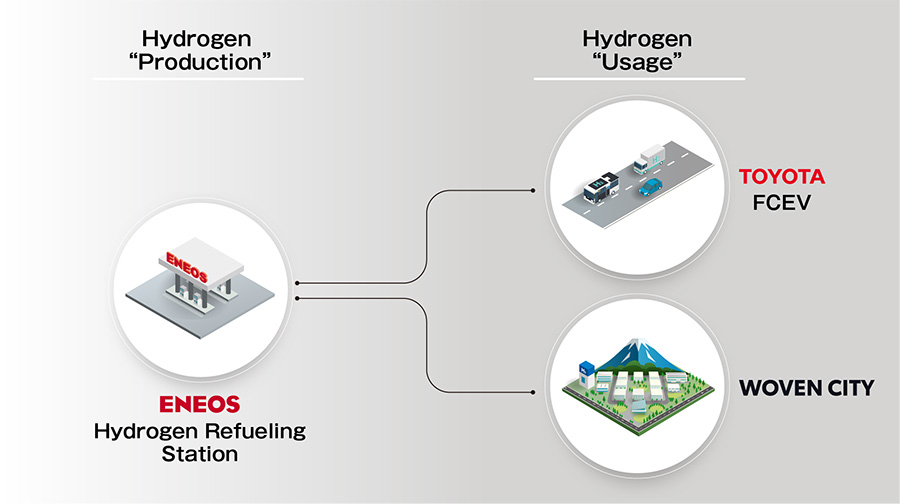ENEOS Corporation (ENEOS) and Toyota Motor Corporation (Toyota) have signed a joint agreement to explore CO2-free hydrogen production and usage at Woven City, the prototype city of the future that Toyota has started to develop in Susono City, Shizuoka Prefecture, Japan. Together with Toyota’s subsidiary Woven Planet Holdings, Inc. (Woven Planet), they will accelerate efforts by managing technical logistics.
As described in the Basic Agreement signed in 2021, ENEOS and Toyota have decided to commence construction and operation of a hydrogen refueling station in close proximity to Woven City to produce and supply CO2-free hydrogen to Woven City and Fuel Cell Electric Vehicles (FCEVs) (Item 1 and 2 set forth below). Together, they will also research and design an efficient hydrogen supply and demand management system (Item 3 described below). The ENEOS hydrogen refueling station is scheduled to begin operations before the opening of Woven City in 2024-2025.
Items to be considered at the time of the Basic Agreement*1
- ENEOS to establish and operate a hydrogen refueling station in close proximity to Woven City
- ENEOS to produce “green hydrogen,” hydrogen derived from renewable energy, by electrolyzers at the aforementioned station and supply it to Woven City to be used at a stationary fuel cell generator that will be installed within Woven City by Toyota
- Promote the use of hydrogen-powered fuel cell mobility for logistics in and nearby Woven City. Validate a base unit*2 of hydrogen demand for those mobility logistics as well as build a supply and demand management system
- Conduct joint advanced research on hydrogen supply at the demonstration hub to be established within Woven City
Items that have been decided in the joint development agreement this time
| Item 1) | Construct a hydrogen refueling station adjacent to Woven City (Scheduled to be constructed at 1576-3, Mishuku Aza Hounokidaira, Susono-city, Shizuoka-Pref., Japan) |
|---|---|
| Item 2) |
|
| Item 3) | Consider connecting the Community Energy Management System (CEMS) of Woven City with the hydrogen EMS of ENEOS to optimize hydrogen production |

The ENEOS hydrogen refueling station will “produce” the hydrogen that will meet the energy needs of “users,” FCEVs in and around Woven City and Woven City as well. This collaboration expedites our progress toward realizing a truly carbon-neutral society and will facilitate and normalize clean energy operations first at Woven City and eventually the world.
Woven City is the project of Toyota aiming to create happiness through mobility of “people,” “goods,” and “information.” It is focused on three pillars. That are: Human-Centered City that makes people happier in their everyday lives, considering the needs of different kinds of people before and during the development of technology; Living Laboratory, the first-of-its-kind test track for mobility where researchers, engineers, and scientists demonstrate innovative ideas and future technologies both virtually and in the real world; and Ever-Evolving City, rooted in Toyota’s kaizen (continuous improvement) approach, is focused on new ideas that provide better mobility of information, goods, and people.
*1 Announced on May 10, 2021 “ENEOS and Toyota Come Together to Make Woven City the Most Hydrogen-Based Society”
*2 Hydrogen can be supplied to FCEVs even during power outages by using stored hydrogen to operate a hydrogen refueling system with a stationary fuel cell generator. This allows the external power supply function of FCEVs to be utilized to provide power support where electricity is needed.
*3 The “base unit” is a standard of measurement required to ensure a result that is both practically valuable to users and commercially viable.
SOURCE: Toyota
